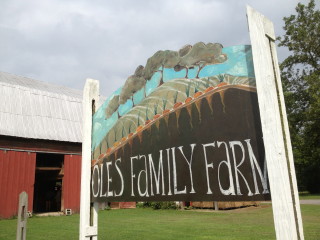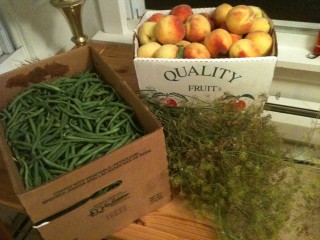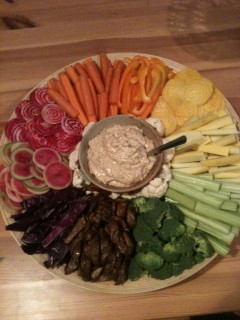Warning: Trying to access array offset on value of type null in /home/devonkarn/rootsnveggies.com/wp-content/themes/herothemetrust/functions.php on line 819
The ABCs of the CSA

Your glass-of-wine count might be higher than the number of degrees on the thermometer right now, but if you’ve been wondering about getting a Community-Supported Agriculture (CSA) produce share this summer, it’s time to get your fleece-covered butt moving – spots at good farms can sell out by mid-February.
First, an ode. Even though I grew up in a house that ate a LOT of vegetables, I never knew what carrots were supposed to taste like until I had a CSA share (sweet, not like a refrigerator case). I never knew what celeriac or kohlrabi was. I didn’t know what cabbage plants looked like in the ground. I hadn’t experienced potatoes so new they didn’t even need butter. I didn’t fully comprehend the kind of hard, all-weather, physical labor – and true passion – that goes into growing good food. I shit you not.
So what is Community Supported Agriculture?

Here’s where most of our produce comes from (besides what’s in my garden) – The Promised Land CSA at the Oles Family Farm.
It’s when a group of people pay a farmer ahead of time for a share of the season’s produce. It’s usually veggies and/or fruit, but can also apply to meat and eggs. In traditional agriculture, a farm spends a lot of money early in the season to buy seeds and compost, repair and fuel equipment, and pay its workers. But it doesn’t get paid until the fields are harvested and the produce is sold. And if it’s a crap harvest year? Too bad – the money’s already spent. The CSA model provides the farmer with the money he or she needs in the spring, and acts as a sort of insurance policy that the farm’s costs will be covered even if dry summers or floods reduce the amount of produce that can be sold (since traditional insurance policies don’t fully cover crop loss).
The farm isn’t the only one who wins here. The CSA member who pays ahead of time gets weekly shares of fresh, seasonal produce, usually grown sustainably and picked shortly before pickup. Because it’s fresher than what is typically found at grocery stores, it has retained all the water-soluble nutrients that are washed away under produce case mist sprayers and lasts days or weeks longer in the fridge. And especially if your CSA farm is organic, you’ll be paying A LOT less for your produce during a typical season than you would if you bought it from a store. (I kept track of the quantity of each week’s share during my first CSA season, compared it to prices for organic produce at the farmers’ market and co-op, and found that it would have cost twice as much to shop for everything myself. More if you count the huge bouquets of flowers and fresh herbs that were available for self-pick at the farm. Yes, I am a little OCD.)
So what if you buy into a CSA share and it’s NOT a typical season? What if you don’t get as much produce because of drought, blight, an early frost, or flood? Well then you’ve contributed to making sure a local farm doesn’t have to throw in the towel and sell its land to a strip mall. That’s a drastic case, but it illustrates a larger point. Farming is a risky business, and that’s partially why fewer people go into the profession than generations ago. If we don’t have smaller, sustainable farms, we don’t have safe food, healthy soil, clean waterways, and vibrant communities. We vote with our dollars; it’s our choice where our food will come from in the future. Bad seasons do happen, but they’re not the norm. And when disaster does strike your farm, it feels SO DAMN GOOD to have helped make sure they’re ok (like when Hurricane Irene wiped out our CSA farm one August).
So should you get a community-supported agriculture share? It’s a good idea for a lot of people, but it’s not for everyone. Here are some things to consider:

This is what most people think a CSA share looks like. It doesn’t. There’s WAY more variety, and the quantities are manageable.
Cooking
Once you’re getting all these fresh, local fruits and veggies every week, you’ll have to do something to them. If you’re not someone who prepares food at home on a regular basis, you’ll be throwing out a lot of really great stuff and a CSA share is probably not a great idea. If you’re someone who cooks fairly regularly, say making dinner 3-4 nights a week with some lunch prep, too, but you’re nervous about getting unfamiliar items in your share, keep in mind that many farms offer recipes that are pretty quick, delicious, relatively easy, and feature the very produce you’re getting. There’s also Google. And CSA veteran friends. And if you have freezer space, you can always prep and freeze summer produce for use over the winter. Look for a farm that will post the week’s share ahead of time on their website, Facebook, or weekly emails so you can do some menu planning. That part’s been crucial in our house.
Variety
Check with the farmers or past members to see what kinds of varieties and quantities you’ll typically be getting (and remember that it’ll be an estimate). Most farms will start out with smaller shares in the spring (because there’s not much ready yet) with lettuce, herbs, scallions, peas, spinach, rhubarb, etc. The shares will grow over the summer until your box is heavy with tomatoes, carrots, potatoes, corn, melons, and a ton of other stuff. In the fall, the share will transition to squashes, cabbages, brussels sprouts, and root veg. Many farms offer the option to add other items to your share (either from the same farm or a partner grower/producer) such as eggs, milk, bread, honey, maple syrup, fruit, and meat. If you can swing it, it’ll mean most of your plate will be local and you’ll only have to brave grocery aisles when you run out of things like tampons and toilet paper.
Share pickup
You will need to go get your farm share either at the farm or at one of several distribution locations around town. Both require that you show up on a specific day or choice of days, during a specific timeframe. Consider this while you’re shopping for a farm: if you’re someone who never gets out of work before 6pm and the pickup options are all between 4-6pm, you’re probably going to miss a lot of shares. If the nearest pickup is 20 miles away, that’s going to get old after the 5th week. Picking up the share at the farm is great if you can do it – you get a great dose of rural serenity, can chat with the farmer, meet other members, and sometimes select among veggie options for your share – but if you’re a tender soul who can’t tolerate a little mud and rain or don’t live anywhere near the farm, those are things to consider as well. Look for a farm with pickup options that fit your real life (not the one you imagine morphing into once you become someone with a CSA). If you split a share with a friend, though, you can alternate weeks, which might change the whole game for you.

Oh, the yumminess. Taste the rainbow of fresh, local flavor.
Cost
At $450-$550 for a summer produce share, it can feel like a lot of money up front, which makes it a no-go if you can’t pull together the funds in one or two payments. If you can, though, you’ll end up saving money if you’re someone who cooks fairly regularly and tends toward local produce. Most shares in the Northeast run from May through October, so it’s 24 weeks of produce at just around $20 per week. Many farms also offer payment plans or reduced-price shares for helping out at the farm. You can also split a share (and cost) with a friend.
So that’s the long and short of it. (Emphasis on LONG, obviously. Sorry.) Do it if you can. We’ve been CSA members for seven years, and I’d never think of NOT doing it at this point. If they still have spots available (or a waiting list with the potential to get a share), I can’t say enough good things about the two high-quality, organic, friendly, incredible farms we’ve experienced:
Burlington, VT – Intervale Community Farm
Buffalo, NY – Promised Land CSA at the Oles Family Farm*
*When we decided to sell our house in Vermont and move back home to Buffalo to be closer to our families in 2012, the first thing I did – before we looked for a place to live – was to find a CSA I felt comfortable with. Yes, really.
